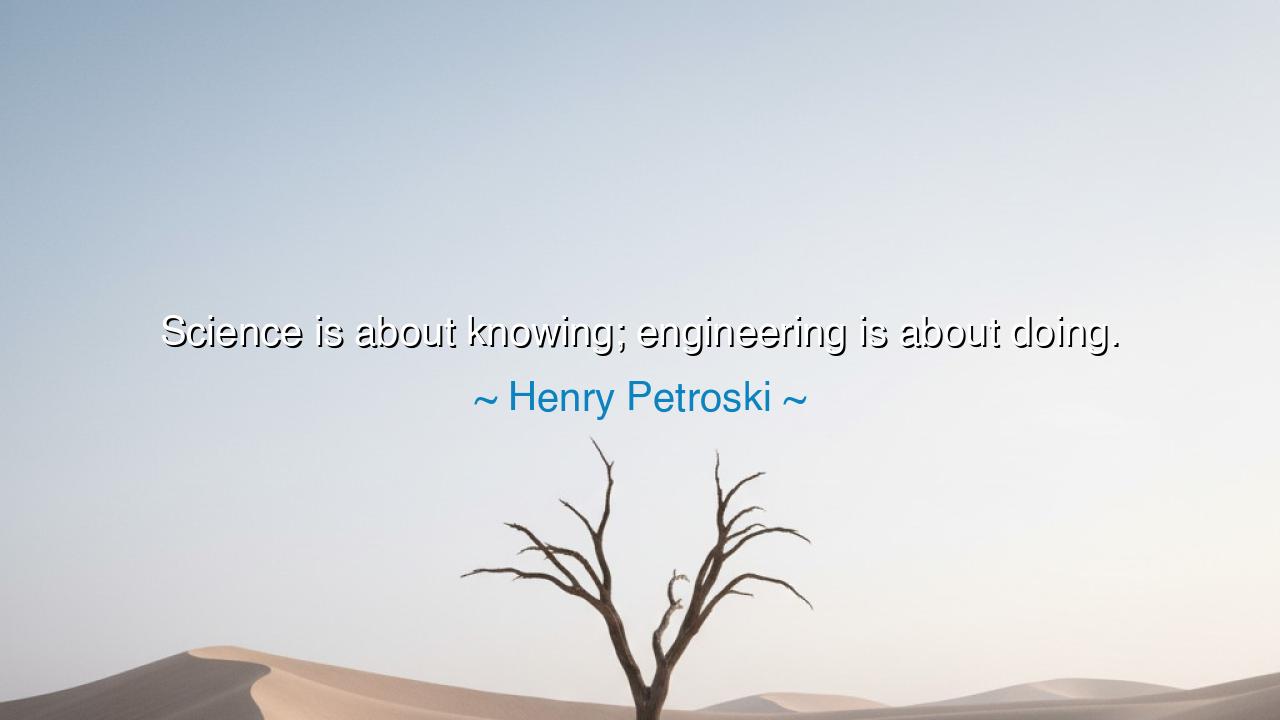
Science is about knowing; engineering is about doing.






“Science is about knowing; engineering is about doing.” Thus spoke Henry Petroski, the chronicler of bridges, tools, and inventions, who dedicated his life to showing how the works of human hands are guided by the wisdom of the human mind. In this short saying, he separates two mighty rivers of human endeavor—science, which seeks to understand, and engineering, which seeks to build—yet he also shows how they flow together to form the sea of progress. Knowledge alone, without action, is inert. Action alone, without knowledge, is reckless. But when knowing and doing unite, the impossible becomes possible, and civilizations rise from the dust.
The origin of these words lies in the age-old partnership between thinker and maker. From the earliest days, man looked upon the world with curiosity: why does the sun rise, why does fire burn, why does water flow? This was science, the hunger to know. Yet soon came the next question: how can I use the sun to tell time, how can I use fire to forge tools, how can I use water to drive wheels? This was engineering, the will to do. Together they lifted mankind from caves to cities, from silence to symphonies, from earth to the stars.
Consider the story of the Wright brothers. They studied the laws of aerodynamics, observing birds in flight, experimenting with airfoils, and recording meticulous data. This was science—the pursuit of knowledge about lift, drag, and balance. But it was not enough to know. They bent wood, stretched canvas, shaped propellers, and dared to climb into a fragile craft to test their understanding. This was engineering—the leap from idea into reality. In 1903, when their machine rose from the sands of Kitty Hawk, it was not science alone, nor engineering alone, but the marriage of both that gave humanity wings.
History gives us another lesson in the great bridges of the world. The Brooklyn Bridge, for instance, was not merely a feat of mathematics and science, but of engineering courage. Calculations predicted its strength, but men had to sink caissons into the riverbed, string cables across a vast span, and endure sickness, injury, and even death. The numbers revealed what could be; the builders proved what would be. In their labor, Petroski’s words find flesh: science is about knowing, engineering is about doing.
Yet let us not think one greater than the other. For knowing without doing leaves dreams unrealized, while doing without knowing leads to folly and ruin. Countless inventions that seemed bold collapsed because their makers scorned the guidance of science. And countless theories that dazzled the mind were forgotten until an engineer gave them form. Wisdom lies in balance: the thinker must respect the builder, and the builder must heed the thinker. Together they are the twin pillars of progress.
The ancients glimpsed this truth. Archimedes, who cried “Eureka!” at his scientific discoveries, also devised engines of war to defend his city. Leonardo da Vinci filled his notebooks with studies of nature, yet also sketched flying machines and bridges. In every age, the greatest minds have known that thought and action must walk hand in hand. To divide them utterly is to cripple both; to unite them is to give birth to wonders.
And so, O listener, take this lesson into your life: seek to know, but also to do. Do not be content with gathering facts if you never act upon them. Do not rush into action without first seeking wisdom to guide your hands. In your work, in your learning, in your daily struggles, let science and engineering dwell together. Test your ideas in practice; shape your dreams into deeds. For as Petroski reminds us, science reveals the truth of the world, but engineering makes that truth useful, tangible, and alive.






AAdministratorAdministrator
Welcome, honored guests. Please leave a comment, we will respond soon